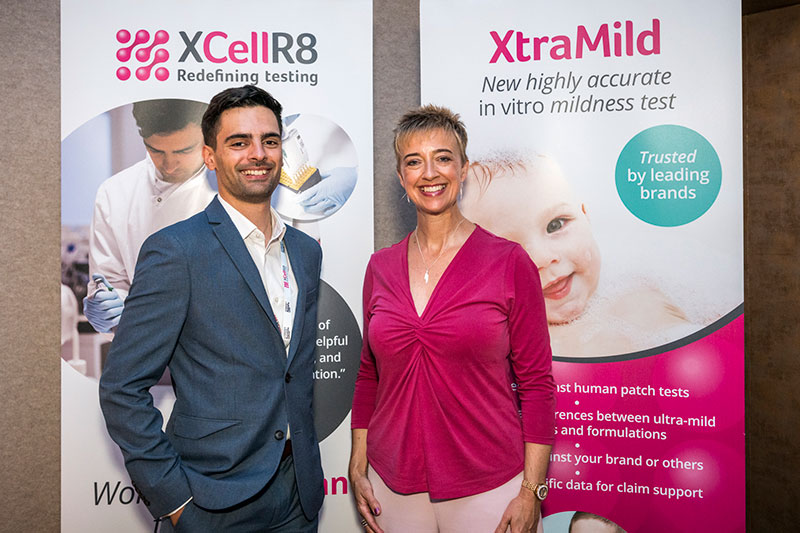Every step of the cosmetics creation process – from ingredients to marketing and sale in various regions – is governed by a comprehensive set of rules.
Since 2014, the annual Cosmetics Business Regulatory Summit has helped clarify this regulatory landscape for professionals in the cosmetics and personal care industry and has swiftly become a must-attend diary date for those seeking to unravel the red tape surrounding beauty.
This year’s event took place last month (8-9 October) in Barcelona at the city’s Catalonia Barcelona Plaza Hotel. Organised by HPCi Media, the two-day event welcomed a diverse span of topics from aerosols to wellness claims via entry criteria for upcoming markets.
EU & US updates
Sandra Ferretti (Obelis Group) was the first speaker of day one and provided updates on the gold standard EU Cosmetics Regulation (1223/2009). However, for the most part, Ferretti zeroed in on Brexit and how the UK’s crashing out of Europe with no deal on 31 October would impact both European cosmetics companies operating in the UK and UK-based businesses selling into the EU.
“If you’re a European manufacturer selling in the UK, if there is a hard Brexit, you will have to have a UK Responsible Person (RP), you will have to register your products in the UK database, there will be some customs tariffs and you will have to change your labelling to mention the UK RP on the label. If you’re a UK manufacturer and you’re selling in the EU, you will become a third country.”
As well as finding a mandatory EU-based RP, re-registering all products on the EU product notification portal (a change of RP is equivalent to a whole new product!), re-labelling products (with the new RP details) and buffering themselves for customs tariffs if they wish to sell in Europe, UK cosmetics companies will have to contend with another, less well-known pothole.
As Ferretti explains: “If you have a UK safety assessor with a UK degree this degree will have to be recognised by one of the EU member states [to sell a product in the EU], otherwise your safety assessments will no longer be valid. And I can tell you that this is a long procedure!”
Extensive changes to US regulations were listed by Sandra Schneider (Dougmar Consultants) – these included the likely Feinstein/Collins Personal Care Products Safety Act, a bill before the US congress, which would allow the FDA greater powers of authority to inspect facilities and to suspend the operations of any that are substandard.
She noted the importance of individual state regulations, especially in California. Here, legislation in the pipeline includes the California Air Resource Board’s move to reduce VOC emissions by 8-10 tonnes/day state wide by 2031; SB-574, which is due to go into effect 1 January 2021 and will require manufacturers to report their fragrance and flavour ingredients; and bill 1162, a proposed California hotel toiletries plastic bottle ban.
The United States Farm Bill of 2018, which removes hemp and hemp derivatives from the definition of ‘marijuana’, enabling CBD to no longer be a controlled substance, was also discussed.
Cannabis in cosmetics
Following Schneider’s talk, the mantle of CBD-containing cosmetics was taken up by Olivia Santoni (Bloom Regulatory). International law obliges control of cannabis plants and products under the UN Single Convention on Narcotic Drugs, she told the audience.
While some countries control all strains, in the EU it is legal to cultivate and supply cannabis plants for hemp fibre or their seeds (for oil) if the variety has a psychoactive THC content not exceeding 0.2% (EU Regulation 1307/2013).

Olivia Santoni
CBD content is not subject to control. However, its use in cosmetics is prohibited if it is prepared as an extract or tincture of cannabis resin.
Because dried stem material and the lower leaves typically contain less than 1% THC, but the female flowers and the resin-producing plant hairs contain more than 20% THC, the part of the plant used is very important; ingredients derived from the seeds or leaves of cannabis, like Cannabis sativa seed oil, extract, powder are not prohibited.
Frustratingly, each EU member state implements the convention differently, which can be a stumbling block for CBD beauty brands.
An important criterion to note when selling a CBD product is claims and making sure these remain cosmetic (moisturising or soothing) and not medicinal, Santoni explained.
Trends adaptation
While CBD is popping up in many new beauty launches, it is not the only trend making waves in the industry.
Indeed, CBD fits nicely into the wider wellness movement; but what exactly is wellness and how can claims can be made in this area? The day one keynote ‘Wellness: the big beauty story’ was delivered by Anni Hood (Well Intelligence), who defined wellness as the lifestyle route to wellbeing, with wellbeing itself defined as “happiness and satisfaction”.
It incorporates factors like sleep, hydration, good nutrition and a consciousness to living, and spans age groups and traditional demographics.
From a beauty standpoint, trends like DIY kitchen beauty, fragranced products that work on ones moods, haptic products and products with an epigenetic angle fit the bill as wellness oriented.
A brand flagged by Hood was haia, which stands for ‘happy as I am’, a gender neutral, ‘clean’ beauty brand whose packaging includes positive affirmations.
Products that allow consumers to tailor the formula to their specific needs at any given time are also very much part of the zeitgeist. However this approach does throw up issues surrounding product safety testing: if there are a large number of formulation end-points, how do we ensure that every iteration is safe to use?
Helen Bannayan (Emulsion Cosmetics) explained how her brand uses a ‘mix in your hand’ approach to product personalisation.
Rather than providing people with a custom blended bottle, Emulsion encourages consumers to buy a base (such as face cream or mask base), one of eight Essential Blends (a mix of essential oils in jojoba oil) and a fragrance, and to mix specified amounts in their hands before application or by layering.

Market surveillance globally
Josep Tous (Product Safety Management) shone a spotlight on the basic principles on international market surveillance.
In the event of a product needing to be recalled, the economic operator placing the product on the market or making the product available on the market is obliged to immediately communicate this action to the authorities.
“If you have an unsafe product and you don’t immediately report this, you will be fined,” Tous said. And if a product is unsafe in one country you have to recall in all jurisdictions.
Creativity meets safety
In a presentation enlivened by the use of scent samples, perfumer Augusti Vidal (Symrise) explained how some classic fragrances are no longer available in their original forms due to restrictions on fragrance ingredients such as lyral, used in YSL’s classic Paris fragrance, for example.
He noted that both naturals and synthetics could create undesired reactions, but he added that it was much easier to control reactions with synthetics, and as a result they’ve become more important in the palette.
He finished by noting that biodegradability and sustainability would be a big focus going forwards, with greater use of fragrance raw materials derived from waste products of the citrus and juicing industry, or even the paper industry.
Change in Asia & Australasia
Other regional or country-focused talks on the summit’s first day included an update on China’s cosmetics regulation by James Wakefield (Delphic HSE). Wakefield outlined key new concepts, including an exemption on previously mandatory animal testing for the Product Safety Risk Assessment of Imported Non-special Use Cosmetics.
He explained that if the safety of such products could be fully ensured via product safety assessment then China’s animal toxicological testing may be bypassed.
Of course there are always exceptions to the rule and, in this case, animal testing will still be mandatory for imported non-special use cosmetics if the product is intended for use on children; includes new ingredients that have been approved but not yet listed; or if the notifier, domestic RP or manufacturer is seen as a priority entity for inspection, or has received punishment related to safety quality in the past three years.

ASEAN cosmetics industry requirements were covered by Alexandra Egan (Oriflame), who explained that while the ten countries in the ASEAN region were theoretically harmonised under the ASEAN Cosmetic Directive, there was nevertheless still divergence between the countries.
All countries across the region have online registration systems for pre-market notification. But there are differences from country to country – for example, some markets require hard copy documentation in addition to online notification, while Vietnam does not recognise RPs from Europe for the certificate of free sale.
Moreover, Egan stressed that, whatever the ASEAN country, acceptance “is very much down to the officer on the day who is looking at your file”.
She recommended building good relationships with the respective local authorities to make life easier.
DKSH’s Robert Koller presented a talk on Japanese regulations; he described it as a unique market where for legal purposes beauty products are segregated into ‘cosmetics’ and ‘quasi-drugs’. While cosmetics are subject to notification and cannot make certain claims, quasi-drugs are subject to marketing approval, possible inspection and claims (provided they remain in ‘prevention’ claims and don’t stray into drug territory with ‘cure’ claims) are permitted.
Australia and New Zealand have seen some major regulatory changes in recent months, which were also presented at the Cosmetics Business Regulatory Summit by James Wakefield (Dlephic HSE).
In Australia, the foremost of these changes is the Therapeutic Goods Act replacing the 2007 Cosmetic Standard as of 1 October 2018. Cosmetics are regulated, but regarded as ‘excluded’ from therapeutic products.
The list of ‘excluded’ goods encompasses deodorants, dental products and nail products, but primary sunscreen is regulated as ‘therapeutic’ with the specific labelling and warning requirements.
Sunscreen products with a secondary function must be broad spectrum, but are ‘excluded’ as long as the SPF is less than 15.
The New Zealand Cosmetic Products Group Standard 2017 has many similarities with EU legislation and its list of permitted and restricted chemicals is designed to be friendly to both the EU and Australian regulations to ease export and import from those regions.
But, as Wakefield noted, there are some differences, so care must be taken with interpretation.
Spray safely
Dorota Keczmerska (Volcke Aerosol Connection) discussed aerosols and the regulations governing this well-loved product format. To do so, she came up with a hypothetical product – volumising dry shampoo for dark hair – to highlight the examples of the regulatory red flags one would have to watch out for if selling in the US and the EU markets.
These include the ingredients used – in the US, non-coated TiO2, which is used to carry the iron oxide pigments, is not allowed in aerosols, while replacement ZnO is banned in the EU – and VOCs.
In the US, for example, maximum VOC levels for dry shampoos are unspecified, but if the product claims ‘volumising’ then it becomes a hair styling product, which is subject to VOC limits, resulting in a ‘wet’ product that is accepted by US consumers but not by Europeans.
Testing times
Demand for vegan cosmetics is soaring; however, few vegan consumers are aware that many non-animal tests nevertheless make use of animal-derived products.
At the Cosmetics Business Regulatory Summit two testing companies discussed vegan-friendly alternatives. Speaking on day one, Carol Treasure (XCellR8) showed the latest developments surrounding XCellR8’s 100% animal-free in vitro mildness testing method.

Her new research project with Cutest developed a prediction model linking XCellR8’s vegan ET50 method (which uses reconstructed human skin) with the in vivo human skin patch test model to create a database of industry leading mild ingredients.
When testing and ranking the irritation potential of four surfactants, the ET50 method correlated with the in vivo clinical scores – and the pattern was the same when surfactant blends, mild surfactant shampoo formulations and finally face masks were tested, even if the differences in mildness were minimal.
MSL’s Ben Elmadi, meanwhile, introduced a microbiological test suitable for vegan beauty products. The classic culture media (CM) and neutraliser formulations traditionally used in microbiological testing include, for example, pancreatic bovine enzymes among other animal materials.
The VeganSure method from MSL dispenses with all animal-derived CM and neutralisers used in the two main cosmetic tests: Microbial Limits and the Preservative Efficacy (Challenge) Test.
Instead, these are replaced with plant-derived and synthetic alternatives such as papaya-derived enzymes, soybean, sugars from potatoes, cornmeal and plant peptones.
Beyond veganism, another trending claim is for protection from the negative effects of blue light on the skin. Dr Jordan Pekov (Lonza) introduced Lonza’s new anti-blue light active, ScreenLight Block.
Using ex vivo skin explants incubated with a 3% ScreenLight Block emulsion, Lonza proved that the synthesis of the antioxidant SOD was boosted by 50% compared with control.
An innovative UV filter and the regulatory hurdles involved in getting said filter to market were the subject of Cham Kang’s (Entekno) speech. Entekno invented a new zinc oxide that acts like a microparticle (so it doesn't enter the skin), but is ‘nano’ in its protective properties, hence its name: MicNo.
Kang noted that regulatory concern surrounding ‘nano’ is “excessive” and exceeds what the actual regulations say, implying that although companies are keen to comply, many are ignorant of the actual regulations.
Sustainability: The bottom line
Day two featured a duo of presentations on the theme of sustainability. Gary Parker (Intertek) delivered ‘Why sustainability should matter to your supply chain’ while Lilian Garcia Lledo (RSPO) discussed sustainable palm oil certification.
Parker provided context with some sobering statistics; that in the heyday of the FMCG lifestyle, the 1960s, the population was just 3 billion, while today’s population is triple that… making a lifestyle that was never truly viable even more unsustainable.
But, if companies are going to make on pack claims around sustainability, they should do so in an informed manner. For example, unsupportable blanket claims like ‘green’ will get you into trouble with bodies like the US FTC. Likewise the FTC takes task with the ‘100% recyclable’ claim.
Biodegradability, meanwhile, is a claim that consumers love above even recycling. But we need to be transparent about whether its biodegradable in the real world to required standards.
When it comes to palm oil, Lledo explained that there are seven principles under which companies producing RSPO certified oil should operate: to behave ethically and transparently; to operate legally; to optimise productivity; respect community and human rights and deliver benefits; support smallholder inclusion; respect workers’ rights and conditions; and protect, conserve and enhance ecosystems and the environment.
Ways in which cosmetics companies can help, she said, included becoming an RSPO member; purchasing RSPO credits to encourage the production of sustainable palm oil; purchasing RSPO certified ingredients, which include Identity Preserved (identifiable to a single certified mill), Segregated (sustainable palm oil from different certified sources) or Mass Balance (sustainable palm oil mixed with ordinary palm oil); and claiming use of RSPO certified products and ingredients to clients on your website and/or on products via the use of the RSPO trademark.
Moving to a less problematic vegetable oil source such as the lower-yield coconut oil would be counterproductive in the long run and would – if everyone did this – result in an even worse ecological impact, she noted.

